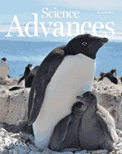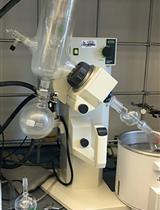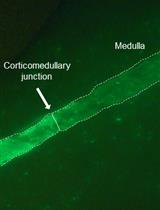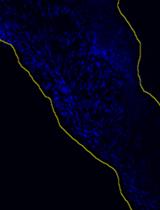- EN - English
- CN - 中文
Surface Engineering and Multimodal Imaging of Multistage Delivery Vectors in Metastatic Breast Cancer
转移性乳腺癌多期转运载体的表面工程和多模态成像
发布: 2021年05月20日第11卷第10期 DOI: 10.21769/BioProtoc.4030 浏览次数: 6113
评审: Raghuveer KavarthapuHaotong LiAnonymous reviewer(s)
Abstract
The design of effective nanoformulations that target metastatic breast cancers is challenging due to a lack of competent imaging and image analysis protocols that can capture the interactions between the injected nanoparticles and metastatic lesions. Here, we describe the integration of in vivo whole-body PET-CT with high temporal resolution, ex vivo whole-organ optical imaging and high spatial resolution confocal microscopy to deconstruct the trafficking of injectable nanoparticle generators encapsulated with polymeric doxorubicin (iNPG-pDox) in pulmonary metastases of triple-negative breast cancer. We describe the details of image acquisition and analysis in a step-wise manner along with the development of a mouse model for metastatic breast cancer. The methods described herein can be easily adapted to any nanoparticle or disease model, allowing a standardized pipeline for in vivo preclinical studies that focus on delineating nanoparticle kinetics and interactions within metastases.
Keywords: In vivo imaging (体内成像)Background
Metastatic cancer accounts for >90% of mortality in cancer patients; yet, effective therapeutic strategies are missing due to the small size, heterogeneity, and dispersed nature of metastatic cancers (Bianchini et al., 2016; Elia et al., 2019). A series of biological barriers hinder the accumulation, and hence, the efficacy of conventional small molecule drugs and nanoparticle-based delivery systems in metastatic cancers (Blanco et al., 2015). Our group has previously demonstrated the sequential and successful negotiation of most, if not all, biological barriers using iNPG-pDox composed of porous silicon microparticle-based injectable nanoparticle generators (iNPG) packaged with poly(lactic-co-glycolic acid) polymer-doxorubicin (pDox) conjugates (Xu et al., 2016). pDox molecules self-assemble into nanoparticles after their release from iNPGs, and iNPG-pDox treatment significantly inhibited tumor metastasis, including a functional cure in 40-50% of mice with pulmonary metastatic breast cancer (Xu et al., 2016). Visualization of the spatiotemporal kinetics of such nanomedicines that effectively target metastases can allow the directed development and rational improvement of other advanced therapies in the future (Goel, 2017).
Despite significant progress in the development of drug delivery systems, limited studies have evaluated the distribution and interactions of such systems in in vivo metastatic settings. Molecular imaging modalities can uncover a wealth of information across multiple length- and time-scales in disease settings; however, the application of rationally combined multiscale imaging methods to assess the biodistribution of complex drug delivery systems in metastatic tumors remains to be performed (Goel, 2017). Such knowledge, in conjunction with mathematical modeling approaches, can predict and evaluate therapeutic responses and efficacies of complex drug delivery systems, eventually being employed to guide the reverse engineering of advanced therapies (Michor, 2011). In this protocol, we provide a detailed guide to designing and implementing a multiscale and multimodal imaging toolkit for the systematic deconstruction of the trafficking and interactions of nanotherapeutics in a metastatic model of breast cancer, as described in our earlier work (Goel et al., 2020).
We first designed a modular orthogonal surface engineering approach for the modification of iNPG-pDox to render them amenable to multimodal imaging (both nuclear and fluorescence imaging) and microscopy without affecting their intrinsic biophysical properties. Such an approach is independent of carrier type, cargo, formulation method, or delivery route, and can be adopted for any nano- or bioengineered platform and implemented in any disease model. Next, we designed and implemented a systematic imaging toolkit composed of: (1) positron emission tomography/computed tomography (PET/CT) for longitudinal in vivo whole-body imaging at a high spatiotemporal resolution; (2) multispectral optical imaging (OI) for ex vivo whole-organ imaging of metastatic lungs; and (3) multispectral confocal microscopy for intra-tissue imaging of iNPG-pDox distribution in metastatic lungs with high spatial resolution (Goel et al., 2020). This protocol includes methods for each of the approaches described above.
Materials and Reagents
T-75 cell culture flasks
Serological pipettes (Thermo Fisher Scientific, catalog numbers: 13-676-10F and 13-676-10M)
FalconTM conical centrifuge tubes (Thermo Fisher Scientific, catalog number: 14-959-53A)
1 cc Exel insulin syringes (28 G, 1 ml, Fisher, catalog number: 14-841-31)
BD 1 ml insulin syringe with slip tip (Fisher, catalog number: 22-253-260)
Sterile filter pipette tips
EppendorfTM tubes (various sizes)
Coverslips
31 G disposable insulin syringes (BD, catalog number: 324921)
ParafilmTM M PM996 all-purpose laboratory film
MilliporeSigmaTM silica gel 60G TLC plates, glass-backed (MilliporeSigma, Catalog number: 1.00384.0001)
26 G × ¾” mouse and rat tail vein Monoject IV catheter (Patterson Veterinary, catalog number: 07-836-8403)
BalB/c mice: Female, 4-6 weeks old (Invigo or The Jackson Laboratory) or another strain suitable for the selected cancer cell line
Murine triple-negative breast cancer cell line expressing luciferase: 4T1-GFP-Luc (ATCC) or another cancer cell line
Discoidal porous silicon particles (iNPG) and pDox nanoparticles (prepared in-house) or another amine-modified nanoparticle of choice (Xu et al., 2016)
2-S-(4-isothiocyanatobenzyl)-1,4,7-triazacyclononane-1,4,7-triacetic acid (p-SC-Bn-NOTA) (Macrocyclics, Dallas, ID: B-605)
0.9% sodium chloride injection USP, 100 ml fill in 150 ml PAB® (B. Braun, NDC number: 00264-1800-32)
Sterile de-ionized water
Phosphate-buffered saline (PBS) solution, pH 7.4 (Thermo Fisher Scientific, catalog number: 10010023)
100 ml filter-sterilized 50 mM EDTA solution
N,N′-dimethylformamide (DMF; MiliporeSigma, catalog number: 227056-100ML)
Dimethyl sulfoxide (DMSO; MiliporeSigma, catalog number: 317275-100ML)
Diisopropylethylamine (MiliporeSigma, catalog number: 387649-100ML)
Isopropanol
0.1 M sodium acetate solution
0.1 M HCl solution
Copper-64 (64Cu; Washington University St. Louis)
AlexaFluorTM 647 NHS ester (Thermo Fisher, catalog number: A20006)
Mouse serum (MiliporeSigma, catalog number: M5905-5ML)
OCT freezing compound (Tissue-Tek® O.C.T. Compound, Sakura® Finetek; VWR, catalog number: 25608-930)
Tissue-Tek® Cryomold® molds/adapters (Sakura® Finetek)
4′,6-diamidino-2-phenylindole (DAPI; Thermo Scientific, prepared according to vendor instructions; catalog number: 62247)
ProLongTM Gold Antifade Mountant (ProLong, catalog number: P36930)
RPMI-1640 medium (ATCC, catalog number: ATCC® 30-2001TM)
Fetal bovine serum (FBS) (GibcoTM, catalog number: 10-082-147)
Pencillin-streptomycin antibiotics (GibcoTM, catalog number: 15-640-055)
Isoflurane (MiliporeSigma, catalog number: Y0000858)
Aluminium stubs (PELCO® pin mount starter kit; PELCO, catalog number: 76250-10)
Recombinant Anti-CD31 antibody [EPR17260-263] (Abcam, catalog number: ab222783)
Goat anti-rabbit IgG H&L (FITC) (Abcam, catalog number: ab6717)
Complete culture medium (see Recipes)
50 mM EDTA solution (see Recipes)
Equipment
InveonTM PET/CT (Siemens Medical Inc., INVEON, catalog number: 138757)
IVIS® Spectrum In vivo Imaging System (PerkinElmer, catalog number: 124262)
Bioscan AR-2000 Radio-TLC Imaging Scanner (Eckert & Ziegler, Valencia, CA)
Scanning electron microscope (Nova NanoSEM 230, Thermo Fisher Scientific, USA)
Zetasizer Nano ZS (Malvern Instruments Ltd., Worcestershire, UK)
Ultraviolet-visible-NIR spectrophotometer (Synergy H4 Hybrid, BioTek, USA)
Wizard2 2-Detector Gamma Counter (PerkinElmer, catalog number: 2470-0020)
EVOS Auto FL System (Thermo Fisher Scientific, USA)
Nikon Eclipse Ti microscope
Centrifuge (Beckman Coulter, model: Avanti® J-26 XPI, catalog number: 393127)
Tissue culture incubator (Sanyo Scientific, catalog number: 133060)
Biological safety cabinet (The Baker company, SterilGARD, catalog number: 101951)
FisherbrandTM IsotempTM Hot Plate Stirrer, Ambient to 540 °C, Ceramic (Fisherbrand, catalog number: SP88854200)
PCR thermal cycler (Bio-Rad Laboratories, model: T100TM, catalog number: 1861096)
Braintree Scientific Diversity Partner Mouse Tail Illuminator Restrainer (Fisher, catalog number: NC0772753)
SimportTM Scientific StainTrayTM Slide Staining System (Fisher, catalog number: 22-045-035)
Software
Inveon Research Workplace (INVEON, Siemens)
Living Image Software (PerkinElmer)
Nikon Elements software (Nikon)
FIJI (NIH)
Microsoft Office Suite
GraphPad Prism
Procedure
文章信息
版权信息
© 2021 The Authors; exclusive licensee Bio-protocol LLC.
如何引用
Readers should cite both the Bio-protocol article and the original research article where this protocol was used:
- Goel, S., Ferrari, M. and Shen, H. (2021). Surface Engineering and Multimodal Imaging of Multistage Delivery Vectors in Metastatic Breast Cancer. Bio-protocol 11(10): e4030. DOI: 10.21769/BioProtoc.4030.
- Goel, S., Zhang, G., Dogra, P., Nizzero, S., Cristini, V., Wang, Z., Hu, Z., Li, Z., Liu, X., Shen, H. and Ferrari, M. (2020). Sequential deconstruction of composite drug transport in metastatic breast cancer.Science Advances 6(26): eaba4498.
分类
癌症生物学 > 通用技术
生物物理学 > 生物工程 > 医用生物材料
分子生物学 > 纳米颗粒
您对这篇实验方法有问题吗?
在此处发布您的问题,我们将邀请本文作者来回答。同时,我们会将您的问题发布到Bio-protocol Exchange,以便寻求社区成员的帮助。
Share
Bluesky
X
Copy link













